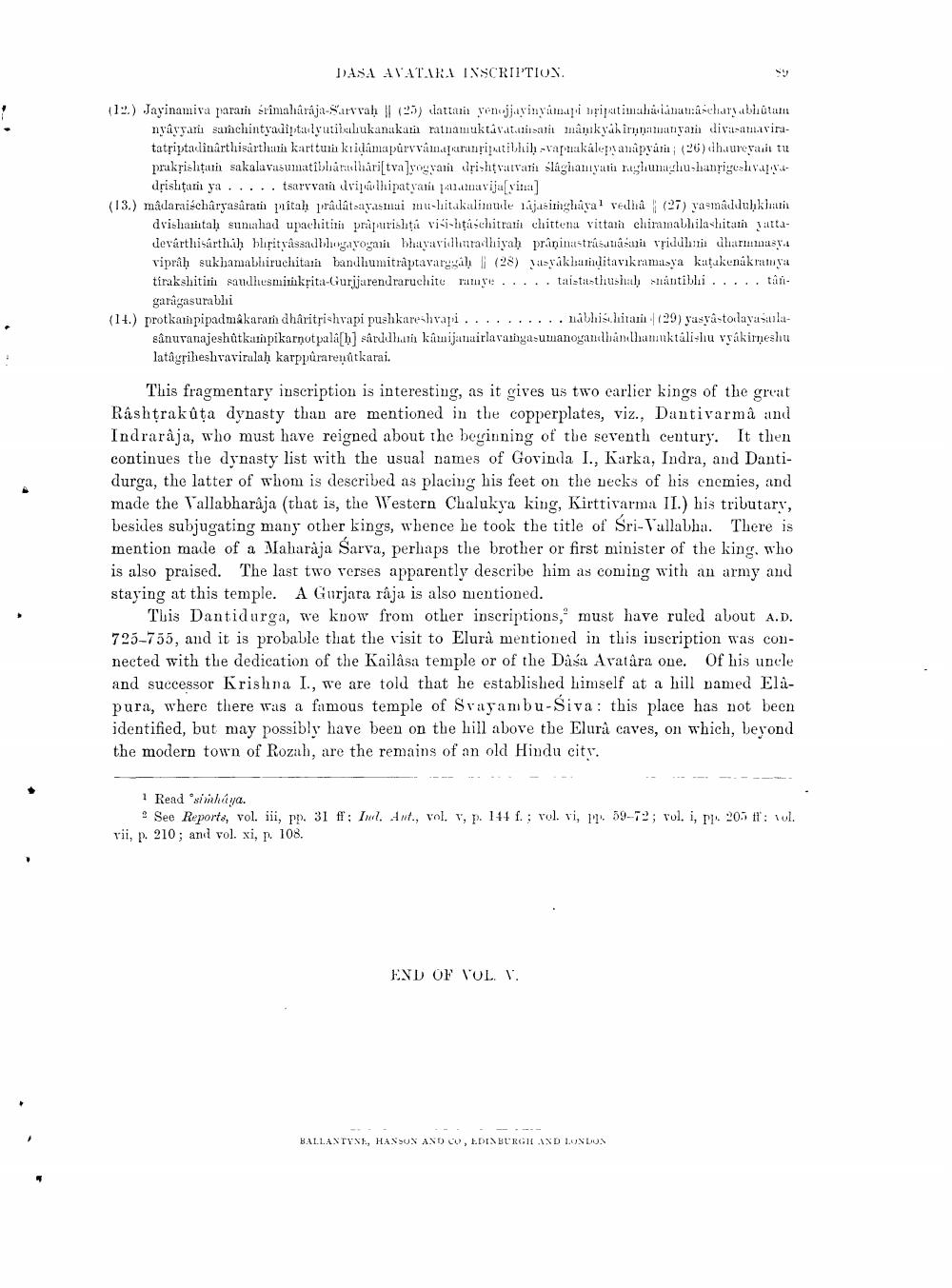________________
!
DASA AVATARA INSCRIPTION.
(12) Jayinamiva para śrimaharaja-Sarvvaḥ || (25) dattan yenojjayinyamapi mripatimahaiananascharyabhūtam nyayyam samchintyadipta yutibaliukanakam ratnamuktavatamisami manikyakiramanyam divasamaviratatriptadinârthisärtha karttui kiidamapurvvâmaparanțipatibhiḥ svapuakálepy anapyam; (26) dhauryai tu prakrishtami sakalavasumatibharadhari[tva]yogyam drishtvaivam slághamiyati raghunaghushanrigeshvapyadrishtam ya.... tsarvvai dvipa hipatyan panamavija[vina]
(13.) mâdaraischâryasaram pitaḥ prâdâtsayasmai mu-hitakalimude ajasinghaya1 vedha (27) yasmadduḥkham dvishamtaḥ sunahad upachitini prapurishta visi-htáschitra chittena vittam chiramabhilashitam yattadevarthisarthaḥ bhrityâssadbhogayogain bhayavidhuradhiyaḥ praninastrasanasani vriddhi dharmmasya vipraḥ sukhamabhiruchitam bandhumitraptavarggah (28) yasyakhanditavikramasya katakenákramya tirakshitim saudhesmimikrita-Gurjjarendraruchite ramye ..taistasthushal snántibhi..... tâйgaragasurabhi
(14.) protkampipadmakaram dhâritṛishvapi pushkareshvapi... nabhis hitam (29) yasyastodayasailasânuvanajeshûtkampikarnotpala[b] sârddhama kamijanairlavaigasumanogandhandhaniktalishu vyakirṇeshu
latagriheshvaviralaḥ karppurarenûtkarai.
This fragmentary inscription is interesting, as it gives us two earlier kings of the great Rashtrakuta dynasty than are mentioned in the copperplates, viz., Duntivarma and Indraraja, who must have reigned about the beginning of the seventh century. It then continues the dynasty list with the usual names of Govinda I., Karka, Indra, and Dantidurga, the latter of whom is described as placing his feet on the necks of his enemies, and made the Vallabharaja (that is, the Western Chalukya king, Kirttivarma II.) his tributary, besides subjugating many other kings, whence he took the title of Sri-Vallabha. There is mention made of a Maharaja Sarva, perhaps the brother or first minister of the king, who is also praised. The last two verses apparently describe him as coming with an army and staying at this temple. A Gurjara rája is also mentioned.
This Dantidurga, we know from other inscriptions, must have ruled about A.D. 725-755, and it is probable that the visit to Elurà mentioned in this inscription was connected with the dedication of the Kailasa temple or of the Dâsa Avatâra one. Of his uncle and successor Krishna I., we are told that he established himself at a hill named Elàpura, where there was a famous temple of Svayambu-Siva: this place has not been identified, but may possibly have been on the hill above the Elurâ caves, on which, beyond the modern town of Rozah, are the remains of an old Hindu city.
1 Read *simhaya.
See Reports, vol. iii, pp. 31 ff; Ind. Ant., vol. v, p. 144 f.; vol. vi, p. 59-72; vol. i, pp. 205 : vol. vii, p. 210; and vol. xi, p. 108.
END OF VOL. V.
BALLANTYNE, HANSON AND CO, EDINBURGH AND LONDON




